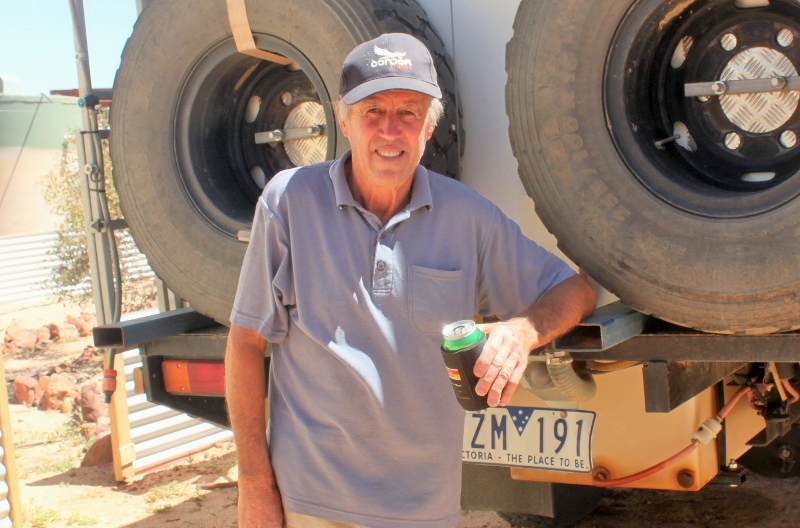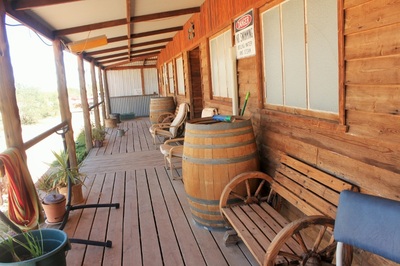Maybe it’s the rhythmic name. Maybe it’s the remoteness. Maybe it’s just that it’s a tiny speck on the edge of the Strzelecki desert.
Whatever it is, Innamincka has a folklore fascination. A bitumen road now stretches west from Brisbane for all but the last 60 km. In outback terms that probably means it’s not really remote any more even if it is almost 400km west of Thargomindah.
At Thargomindah I had been looking forward to seeing “CONDUIT between above and below”, the celebrated sculpture hailing that life force of the inland - the Great Artesian Basin. Sculptor Frederick White created a field of 52 poles spearing into the ground, one for each week of the year the outback depends on water coming from beneath the ground.
Flow from a bore created a bottomless effect in the pooling water around the cylinders. Or so I read. “CONDUIT” isn’t there anymore.
Experts are worried that the Great Artesian Basin isn’t infinite and the outback’s enthusiastic spearing, releasing water from about 4700 bores at an average depth of 500m, is drying nature’s subterranean reservoir up faster than it can be replaced.
Ground water apparently can take 20,000 years to drip into the great underground basin so authorities have been busily capping bores that had been left to spurt freely, evaporating without storage.
The bore creating the Thargomindah sculpture on the outskirts of town did just that so it was capped and the sculpture taken away. No one we spoke to in town seemed too sure where “CONDUIT” was now or what it going to happen next.
Innamincka, just across the South Australian border, doesn’t have a sculpture but it does have an eye-catcher of a building as you drive into town, a grand, graceful two-storeyed ... what was it? Old or new? Residence or headquarters?
As we peered for a sign a ute pulled up and we again encountered that extraordinary outback hospitality that begins where the coastal green and greed ends.
“Need any help?” asked Jeff Matthews. Just having a look around, we said. “Are you stopping?” No, just visiting and looking for a bite for lunch and topping up with fuel and if possible water.
“No water in Innamincka,” said Jeff, “but we just had three and half inches of rain so I’ve got plenty at my place. Follow me and I’ll top you up.”
He pointed happily at Cooper Creek gurgling across the town causeway and told us the building we were examining was the old Inland Mission, restored thanks to Australia’s electronics billionaire Dick Smith.
“He didn’t do it all with his own money, of course, but he’s pretty good at getting other people to part with theirs.”
We followed the ute past the town’s clutter of mining paraphernalia to a garage where he topped up our water, showed us the solar powered boat he’d built, the motorhome he’s built (above) and offered us a cup of tea in the surprisingly comfortable air-conditioned quarters he had renovated on the corner of the building.
The guy has built a lot of stuff, including the impressive rustic Cooper Creek Homestay accommodation.
He arrived in Innamincka in the late 1990s with his wife Julie and daughters Miranda and Ali. They had roamed around Australia most of their married life. “We rammed a fair bit into our lives.” The girls had never been to school. Julie, with a Bachelor of Education, had home-schooled them.
I peered at a family photo on the wall. Miranda had married a German microbiologist and gained her masters degree in political science at Heidelberg university. Ali and her partner ran the Cooper Creek Homestay, which can seat 30 in the spacious kitchen.
Innamincka has a permanent population of about 17. Only four, including Jeff and Julie, are freehold landowners.
“Everyone else is either a manager or staff here,” said Jeff. “I suppose there’s also the National Parks but we don’t really count them. They’re something different.”
We drove down to inspect the cool and welcoming Homestay with a variety of bed arrangements in self-contained rooms. Business had been flat out last year but had slowed down a little with the ease-down in mining. Tourists would start to trickle in as the temperatures dropped.
At the Innamincka Trading Post we paid $1.90 a litre for fuel and had an ice cream for lunch. No take-away food was on sale. “You’re early in the season,” we were told once again. “We don’t do food during summer.”
Jeff was waiting to escort us out of town to make sure we didn’t miss the turn-off south to the Old Strzelecki Track. One day we are going back to see what else Jeff has built at Innamincka and rest our heads in what is considered outback luxury at the Cooper Creek Homestay.
Whatever it is, Innamincka has a folklore fascination. A bitumen road now stretches west from Brisbane for all but the last 60 km. In outback terms that probably means it’s not really remote any more even if it is almost 400km west of Thargomindah.
At Thargomindah I had been looking forward to seeing “CONDUIT between above and below”, the celebrated sculpture hailing that life force of the inland - the Great Artesian Basin. Sculptor Frederick White created a field of 52 poles spearing into the ground, one for each week of the year the outback depends on water coming from beneath the ground.
Flow from a bore created a bottomless effect in the pooling water around the cylinders. Or so I read. “CONDUIT” isn’t there anymore.
Experts are worried that the Great Artesian Basin isn’t infinite and the outback’s enthusiastic spearing, releasing water from about 4700 bores at an average depth of 500m, is drying nature’s subterranean reservoir up faster than it can be replaced.
Ground water apparently can take 20,000 years to drip into the great underground basin so authorities have been busily capping bores that had been left to spurt freely, evaporating without storage.
The bore creating the Thargomindah sculpture on the outskirts of town did just that so it was capped and the sculpture taken away. No one we spoke to in town seemed too sure where “CONDUIT” was now or what it going to happen next.
Innamincka, just across the South Australian border, doesn’t have a sculpture but it does have an eye-catcher of a building as you drive into town, a grand, graceful two-storeyed ... what was it? Old or new? Residence or headquarters?
As we peered for a sign a ute pulled up and we again encountered that extraordinary outback hospitality that begins where the coastal green and greed ends.
“Need any help?” asked Jeff Matthews. Just having a look around, we said. “Are you stopping?” No, just visiting and looking for a bite for lunch and topping up with fuel and if possible water.
“No water in Innamincka,” said Jeff, “but we just had three and half inches of rain so I’ve got plenty at my place. Follow me and I’ll top you up.”
He pointed happily at Cooper Creek gurgling across the town causeway and told us the building we were examining was the old Inland Mission, restored thanks to Australia’s electronics billionaire Dick Smith.
“He didn’t do it all with his own money, of course, but he’s pretty good at getting other people to part with theirs.”
We followed the ute past the town’s clutter of mining paraphernalia to a garage where he topped up our water, showed us the solar powered boat he’d built, the motorhome he’s built (above) and offered us a cup of tea in the surprisingly comfortable air-conditioned quarters he had renovated on the corner of the building.
The guy has built a lot of stuff, including the impressive rustic Cooper Creek Homestay accommodation.
He arrived in Innamincka in the late 1990s with his wife Julie and daughters Miranda and Ali. They had roamed around Australia most of their married life. “We rammed a fair bit into our lives.” The girls had never been to school. Julie, with a Bachelor of Education, had home-schooled them.
I peered at a family photo on the wall. Miranda had married a German microbiologist and gained her masters degree in political science at Heidelberg university. Ali and her partner ran the Cooper Creek Homestay, which can seat 30 in the spacious kitchen.
Innamincka has a permanent population of about 17. Only four, including Jeff and Julie, are freehold landowners.
“Everyone else is either a manager or staff here,” said Jeff. “I suppose there’s also the National Parks but we don’t really count them. They’re something different.”
We drove down to inspect the cool and welcoming Homestay with a variety of bed arrangements in self-contained rooms. Business had been flat out last year but had slowed down a little with the ease-down in mining. Tourists would start to trickle in as the temperatures dropped.
At the Innamincka Trading Post we paid $1.90 a litre for fuel and had an ice cream for lunch. No take-away food was on sale. “You’re early in the season,” we were told once again. “We don’t do food during summer.”
Jeff was waiting to escort us out of town to make sure we didn’t miss the turn-off south to the Old Strzelecki Track. One day we are going back to see what else Jeff has built at Innamincka and rest our heads in what is considered outback luxury at the Cooper Creek Homestay.








 RSS Feed
RSS Feed
